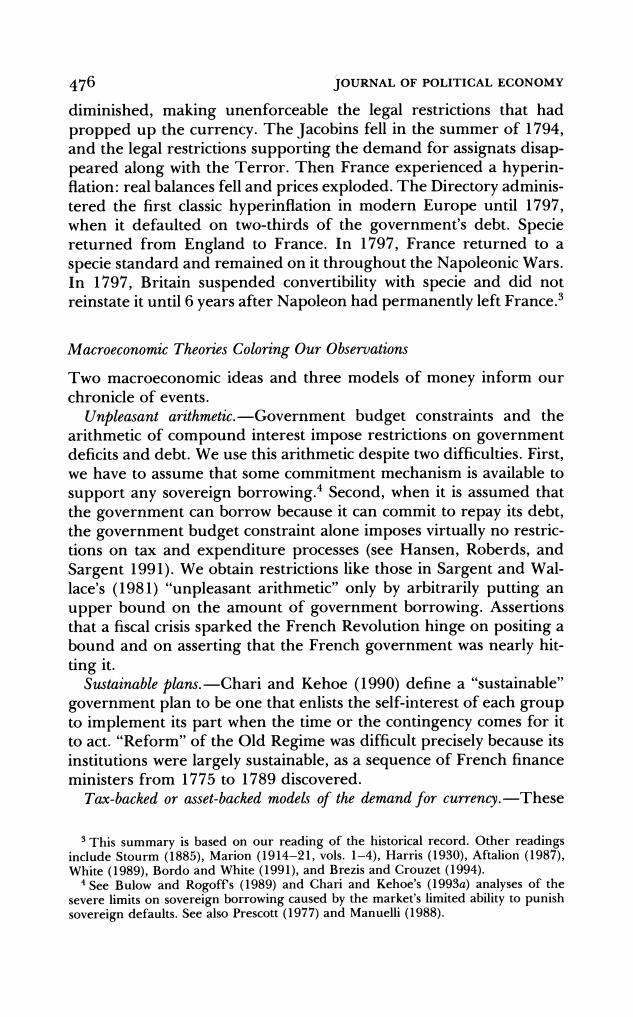正在加载图片...

476 JOURNAL OF POLITICAL ECONOMY diminished,making unenforceable the legal restrictions that had propped up the currency.The Jacobins fell in the summer of 1794, and the legal restrictions supporting the demand for assignats disap- peared along with the Terror.Then France experienced a hyperin- fation:real balances fell and prices exploded.The Directory adminis- tered the first classic hyperinflation in modern Europe until 1797, when it defaulted on two-thirds of the government's debt.Specie returned from England to France.In 1797,France returned to a specie standard and remained on it throughout the Napoleonic Wars. In 1797,Britain suspended convertibility with specie and did not reinstate it until 6 years after Napoleon had permanently left France.3 Macroeconomic Theories Coloring Our Observations Two macroeconomic ideas and three models of money inform our chronicle of events. Unpleasant arithmetic.-Government budget constraints and the arithmetic of compound interest impose restrictions on government deficits and debt.We use this arithmetic despite two difficulties.First, we have to assume that some commitment mechanism is available to support any sovereign borrowing.4 Second,when it is assumed that the government can borrow because it can commit to repay its debt, the government budget constraint alone imposes virtually no restric- tions on tax and expenditure processes (see Hansen,Roberds,and Sargent 1991).We obtain restrictions like those in Sargent and Wal- lace's (1981)"unpleasant arithmetic"only by arbitrarily putting an upper bound on the amount of government borrowing.Assertions that a fiscal crisis sparked the French Revolution hinge on positing a bound and on asserting that the French government was nearly hit- ting it. Sustainable plans.-Chari and Kehoe (1990)define a "sustainable" government plan to be one that enlists the self-interest of each group to implement its part when the time or the contingency comes for it to act."Reform"of the Old Regime was difficult precisely because its institutions were largely sustainable,as a sequence of French finance ministers from 1775 to 1789 discovered. Tax-backed or asset-backed models of the demand for currency.-These 3This summary is based on our reading of the historical record.Other readings include Stourm (1885),Marion (1914-21,vols.1-4),Harris(1930),Aftalion(1987), White (1989),Bordo and White (1991),and Brezis and Crouzet(1994). 4See Bulow and Rogoffs (1989)and Chari and Kehoe's (1993a)analyses of the severe limits on sovereign borrowing caused by the market's limited ability to punish sovereign defaults.See also Prescott(1977)and Manuelli (1988).476 JOURNAL OF POLITICAL ECONOMY diminished, making unenforceable the legal restrictions that had propped up the currency. The Jacobins fell in the summer of 1794, and the legal restrictions supporting the demand for assignats disappeared along with the Terror. Then France experienced a hyperinflation: real balances fell and prices exploded. The Directory administered the first classic hyperinflation in modern Europe until 1797, when it defaulted on two-thirds of the government's debt. Specie returned from England to France. In 1797, France returned to a specie standard and remained on it throughout the Napoleonic Wars. In 1797, Britain suspended convertibility with specie and did not reinstate it until 6 years after Napoleon had permanently left France.3 Macroeconomic Theories Coloring Our Observations Two macroeconomic ideas and three models of money inform our chronicle of events. Unpleasant arithmetic.-Government budget constraints and the arithmetic of compound interest impose restrictions on government deficits and debt. We use this arithmetic despite two difficulties. First, we have to assume that some commitment mechanism is available to support any sovereign borrowing.4 Second, when it is assumed that the government can borrow because it can commit to repay its debt, the government budget constraint alone imposes virtually no restrictions on tax and expenditure processes (see Hansen, Roberds, and Sargent 1991). We obtain restrictions like those in Sargent and Wallace's (1981) "unpleasant arithmetic" only by arbitrarily putting an upper bound on the amount of government borrowing. Assertions that a fiscal crisis sparked the French Revolution hinge on positing a bound and on asserting that the French government was nearly hitting it. Sustainable plans. -Chari and Kehoe (1990) define a "sustainable" government plan to be one that enlists the self-interest of each group to implement its part when the time or the contingency comes for it to act. "Reform" of the Old Regime was difficult precisely because its institutions were largely sustainable, as a sequence of French finance ministers from 1775 to 1789 discovered. Tax-backed or asset-backed models of the demand for currency. -These 3This summary is based on our reading of the historical record. Other readings include Stourm (1885), Marion (1914-21, vols. 1-4), Harris (1930), Aftalion (1987), White (1989), Bordo and White (1991), and Brezis and Crouzet (1994). 4 See Bulow and Rogoff s (1989) and Chari and Kehoe's (1993a) analyses of the severe limits on sovereign borrowing caused by the market's limited ability to punish sovereign defaults. See also Prescott (1977) and Manuelli (1988)